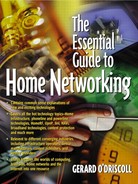SUMMARY
The explosion in demand for high-speed Internet access combined with the push by service providers to offer integrated voice, data, and entertainment services has fuelled the development of a new range of products called residential gateways. These new gateways allow individuals to control in-home appliances from a single console. A residential gateway is best described as an intelligent hardware device that connects home-based Web devices and appliances to the Internet. This chapter has examined the various types of residential gateways and how they allow service providers to deliver integrated services such as data, video, and voice to the home. The cable industry, for instance, is currently spending billions of dollars in rebuilding its cable network to support secure and reliable two-way broadband connectivity. At the same time, there is an explosion of demand from consumers using their home PCs to access the Internet at high speeds. The cable industry is in a unique position to offer these high-speed data services rapidly. People who want to connect their PCs and consumer electronic devices to these "fat pipes" need to purchase a device called a cable modem. Most cable modems currently available are compliant with a particular specification. The presence of open, well-accepted standards leads to competitive pricing from multiple cable modem suppliers. Also on offer from the TV industry is a residential gateway device called a digital set-top box. Set-tops are used to connect in-home networks to a high-speed Internet pipeline. Many set-top box manufacturers have announced a new set-top reference platform called a PVR. These new devices have two tuners and enable simultaneous recording and viewing of live TV broadcasts. Analysts say these systems are going to change the way people watch television. By 2004, 14 million television viewers will be using PVRs to control their programming, estimates Forrester Research analyst Josh Bernoff. ReplayTV and TiVo are the best-known devices; others are due out soon, including Dishplayer, which will incorporate a WebTV net-browsing service. DSL technologies, which allow existing phone lines to be used simultaneously for high-speed Web and voice traffic, are the main competitors to cable modems. For phone companies, DSL modems represent a competitive revenue-generating alternative to cable modems and digital set-top boxes. With the rapid increase in demand for high-speed data services, DSL modems offer telecommunications providers with a technology that increases the bandwidth of the local loop without making huge investments in new fiber technologies. To make use of DSL technologies, the consumer would buy a modem in a local retail store and connect it directly into one of the phone jacks at home. In 1999, hardware companies began shipping a new generation of residential gateways called home servers that connect PCs, audio-video equipment, and household appliances to the Internet.
